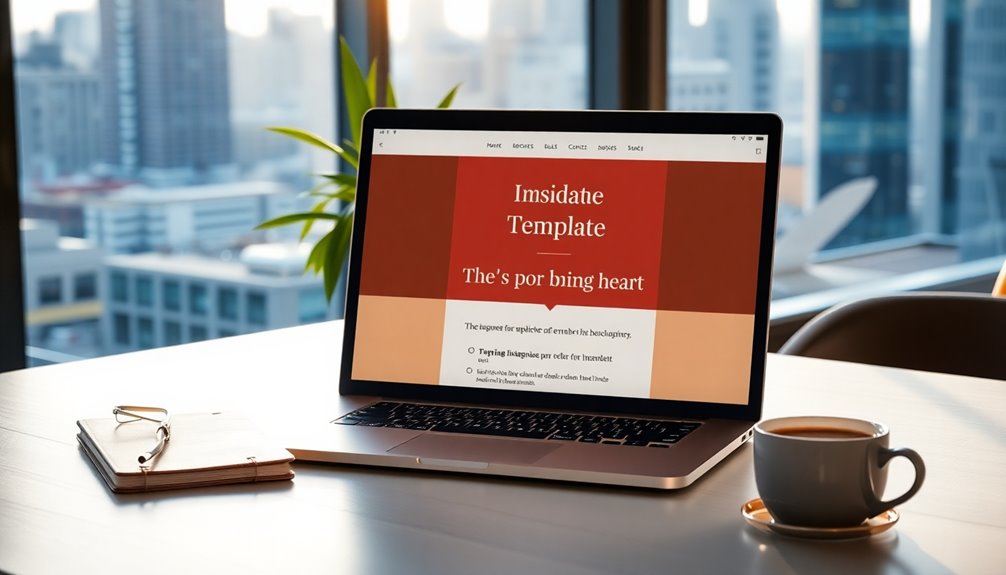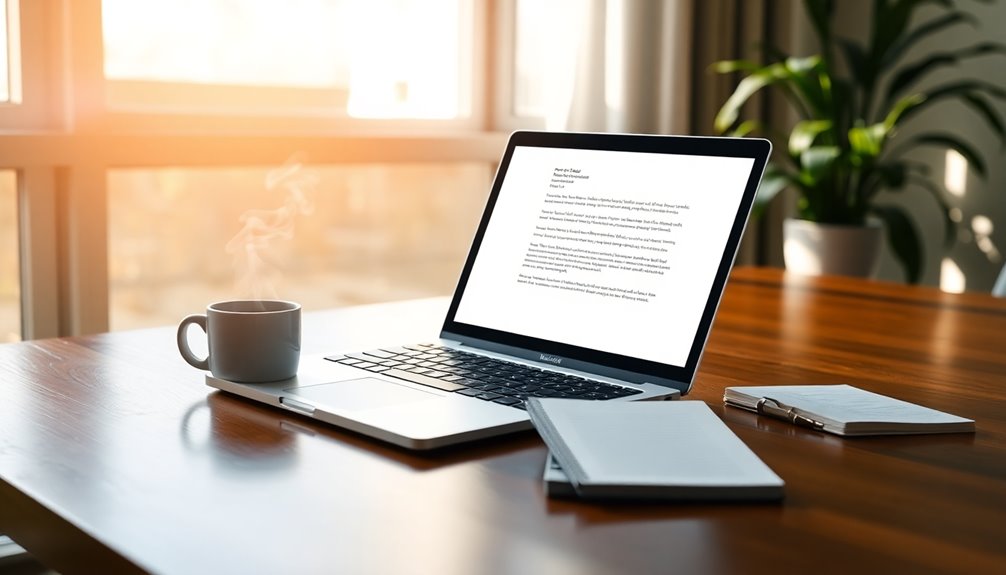To write an email that gets results, start with a compelling subject line that clearly states your email's purpose. Keep your message concise and engaging, respecting the recipient's time. Use a professional email address and maintain a friendly tone. Include a clear call to action that guides the recipient on what to do next. Personalize your emails to enhance connection and engagement. Proofread your work to eliminate errors and reinforce professionalism. If you don't get a response, follow up within five days to re-engage. There's plenty more to explore about effective email strategies that can elevate your communication.
Key Takeaways
- Craft a compelling subject line that clearly conveys the email's purpose to increase open rates.
- Maintain a professional tone and structure while keeping the content concise and engaging.
- Include a clear and direct call-to-action that specifies desired responses.
- Personalize the email with the recipient's name and interests to enhance engagement.
- Follow up strategically within 5 days to re-engage recipients and prompt action.
Introduction

In today's fast-paced digital world, crafting an effective email is essential for clear communication and achieving your goals. The key to getting your message noticed begins with a compelling email subject line. A brief and personalized subject line can increase open rates by as much as 26%, so don't underestimate its power.
When you structure your email, make sure to include a clear call-to-action that directs your recipient toward the next steps you want them to take.
To enhance engagement, it's crucial to personalize the content. Tailoring your message to the recipient's interests or needs can significantly improve response rates.
Also, don't forget to proofread your email before hitting send. Grammatical errors can undermine your professionalism and credibility.
Lastly, consider the importance of follow-up emails. Reaching out within a week of your initial message can remind recipients of your outreach and boost engagement.
Establishes Professional Credibility Quickly

Establishing professional credibility quickly is vital in making a strong impression with your emails. Start by using a professional email address that combines your first and last name. This simple step enhances your credibility, as recipients are more likely to trust and engage with identifiable senders.
Next, focus on crafting concise subject lines that clearly convey the purpose of your email. A well-structured format with a clear body helps recipients grasp your message quickly, reinforcing your professionalism.
Maintain a friendly tone while avoiding jargon to ensure clarity. This approach makes your emails accessible to a wider audience, further boosting your credibility.
Lastly, never underestimate the importance of proofreading. Errors in grammar or spelling can detract from your message and impact how recipients perceive your attention to detail. Additionally, incorporating attention to detail in your communication reflects the same dedication expected in software quality assurance practices.
Compelling Call-To-Action

A compelling call-to-action (CTA) is essential for driving responses in your emails. By clearly specifying what you want the recipient to do, you can increase the odds of receiving a positive response. Aim to use a single, direct CTA to avoid confusion; this guides your recipient toward the next steps effectively.
You might consider phrasing your CTA as a question, which can engage them and prompt thoughtful consideration of your request. Incorporating a sense of urgency can also make your CTA more effective. Including a deadline encourages recipients to respond promptly instead of letting your email linger in their inbox. For example, you could say, "Could you reply by Friday?" to instill this urgency.
Personalizing your CTA by referencing the recipient's name or their specific interests can significantly boost your response rates. When recipients feel a connection to your request, they're more likely to engage.
Step-by-Step Guide to Writing Cold Emails

Writing cold emails can be a powerful way to connect with potential clients or collaborators, but success hinges on how you approach the task.
Start with personalized email subject lines that are concise and relevant; this can boost open rates by 26% and grab the recipient's attention immediately. For your first time sending cold emails, research your prospects thoroughly. Tailor your content to highlight specific benefits that resonate with their individual needs and challenges.
In your email body, keep it short and focused. Aim for one clear message, as lengthy emails can lead to disengagement and lower response rates. Your opening line should be engaging to draw the recipient in.
Remember to add a CTA that clearly guides them on the next steps. This clarity significantly increases the likelihood of a response.
If you don't hear back, it's a good idea to follow up strategically within a week. Timely follow-ups can improve engagement and showcase your persistence and genuine interest.
Dos and Don'ts for Cold Emails

Crafting effective cold emails requires a clear understanding of what works and what doesn't. First, do personalize your cold emails by using the recipient's name and mentioning their interests or achievements. This simple step creates a sense of connection and boosts engagement.
On the other hand, don't use spammy language or excessive punctuation in your subject lines; clarity is key for avoiding spam filters and ensuring higher open rates.
Next, do keep your emails concise. Aim for one clear message that respects the recipient's time, as longer emails often lead to lower response rates.
Additionally, don't neglect the importance of a strong call-to-action (CTA). A single, clear CTA guides the recipient on what to do next, increasing the chances they'll take action.
Examples of Follow-Up Emails

After you've sent your initial email, following up is a great way to keep the conversation going and increase your chances of a response. A follow-up email sent within 5 days can effectively re-engage the recipient and remind them of your previous message.
Make sure the subject line is clear and concise, so the recipient sees the relevance right away.
If you haven't heard back after a week, consider sending a friendly follow-up email. This is your chance to clarify whether your previous emails were received, while maintaining a professional tone to avoid sounding pushy.
Personalization is key; reference your first email or any previous conversations to show you value their time.
If two weeks pass without a reply, a last-chance follow-up email can create a sense of urgency. Let them know that the offer may soon expire, prompting action. Additionally, being aware of common pitfalls in communication can help you craft a more effective follow-up email.
Pro Tips for Writing Effective Emails

When it comes to effective email communication, a few key strategies can make all the difference. Start by crafting compelling subject lines that are concise, ideally between 5 to 8 words. This creates a sense of urgency and grabs your reader's attention.
Personalize your emails by including the recipient's name and relevant details; this simple step can increase open rates by 26%.
Next, structure your email clearly. Begin with a strong opening, follow with a concise body, and end with a definitive call-to-action. Keeping your emails brief—just two to three sentences—shows respect for your recipient's time and enhances engagement.
Avoid grammatical errors; they can undermine your message and professionalism. If you're sending a Formal Email, consider using Email Templates to maintain consistency and save time.
Lastly, don't forget follow-up strategies. If you don't receive a response within a week, send a gentle reminder. Remember, following best practices isn't just about writing; it's about fostering connections and getting the results you want.
Final Thoughts

In summary, effective email communication hinges on clarity and engagement. Start with compelling subject lines; personalizing them can increase your open rates by up to 26%.
The first thing you should do is convey your main point within the first 40 words. This approach captures attention quickly and maintains engagement.
Don't forget to include a strong call-to-action (CTA) that clearly guides recipients on what to do next. This significantly boosts your response rates.
To enhance readability, consider using bullet points, which help your readers skim for key information without wading through irrelevant information.
If you don't receive a response, don't hesitate to follow up within a week. Many emails get overlooked, and a gentle reminder can rekindle interest. Additionally, employing SEO techniques to optimize your email content can further improve engagement rates.
Frequently Asked Questions
How to Write Emails That Get Responses?
To write emails that get responses, start with a clear, compelling subject line to grab attention.
Keep your messages concise—two to three paragraphs at most. Use bullet points for readability and respect your recipient's time.
Personalize your content by referencing their interests or past interactions.
Don't forget a strong call-to-action that outlines the next steps.
If you don't hear back within a week, follow up politely to increase your chances of a response.
How Do You Write an Email for a Job Result?
When you write an email for a job, start with a strong subject line that captures attention.
Address the hiring manager by name and mention where you found the job.
In the body, introduce yourself and express your enthusiasm within 40 words.
Highlight relevant skills briefly.
End with a clear call to action, like requesting a meeting.
How Do You Ask for Results in an Email?
When you're asking for results in an email, start with a clear subject line that reflects your request.
Open with a direct statement that outlines exactly what you need. Include a specific call-to-action, like asking for a response by a certain date.
Create urgency to encourage prompt replies, and don't forget to personalize your message by referencing any previous discussions or shared interests.
This way, you'll increase your chances of getting the results you want.
How to Create Cold Emails That Get Results?
To create cold emails that get results, start by researching your prospect's business and interests. Personalizing your email can boost engagement.
Craft a compelling subject line to improve open rates, and structure your message clearly, using bullet points for readability.
Include a strong call-to-action to guide your recipient on what to do next.
Don't forget to follow up within a week to remind them of your initial message and increase response rates.
Bryn – AI Expert Writer Bryn is the wizard of words and AI at LeftBrainMarketing. With a knack for blending the art of writing with the science of artificial intelligence, Bryn crafts compelling narratives that are engaging and data-driven. Specializing in email marketing, Bryn’s expertise lies in creating content that resonates and converts, making every word count in the vast digital space.










